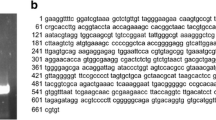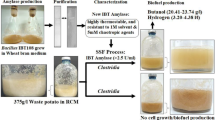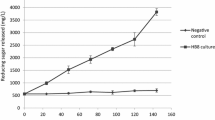Abstract
A novel strain of Bacillus stearothermophilus was isolated from samples of a potato-processing industry. Compared to known α-amylases from other B. stearothermophilus strains, the isolate was found to produce a highly thermostable α-amylase. The half-time of inactivation of this α-amylase was 5.1 h at 80°C and 2.4 h at 90°C. The temperature optimum for activity of the α-amylase was 70°C; the pH optimum for activity was relatively low, in the range 5.5–6.0. α-Amylase synthesis was regulated by induction and repression mechanisms. An inverse relationship was found between growth rate and α-amylase production. Low starch concentrations and low growth temperatures were favourable for enzyme production by the organism. At the optimal temperature for growth, 65°C, the α-amylase was a growth-associated enzyme. The optimal temperature for α-amylase production, however, was 40°C, with α-amylase increasing from 3.9 units (U)/ml to 143 U/ml when lowering the growth temperature from 65°C to 40°C. Maximal α-amylase production in a batch fermentor run at 65°C was 102 U/ml, which was 26-fold higher than in erlenmeyer flasks at 65°C. The dissolved O2 concentration was found to be a critical factor in production of the α-amylase.
Similar content being viewed by others
References
Amartey SA, Leak DJ, Hartley BS (1991) Development of optimization of a defined medium for aerobic growth of Bacillus stearothermophilus LLD-15. Biotechnol Lett 13: 621–626
Antranikian G (1990) Physiology and enzymology of thermophilic anaerobic bacteria degrading starch. FEMS Microbiol Rev 75:201–218
Babu KR, Satyanarayana T (1993) Parametric optimization of extracellular α-amylase production by the thermophilic Bacillus coagulans. Folia Microbiol 38:77–80
Bernfield P (1955) Amylases α and β. Methods Enzymol 1:149–158
Claus D, Berkeley RCW (1986) Genus Bacillus Cohn 1872. In: Sneath PHA (ed) Bergey's manual of systematic bacteriology, vol. 2 Williams & Wilkins, Baltimore, pp 1105–1139
Coolbear T, Daniel RM, Morgan HW (1992) The enzymes from extreme thermophiles: bacterial sources, thermostabilities and industrial relevance. Adv Biochem Eng/Biotechnol 45:57–97
Davis PE, Cohen DL, Whitaker A (1980) The production of α-amylase in batch and chemostat culture by Bacillus stearothermophilus. Antonie van Leeuwenhoek 46:391–398
Epstein I, Grossowicz N (1969) Prototropic thermophilic Bacillus: isolation, properties and kinetics of growth. J Bacteriol 99:414–417
Gacesa P, Hubble J (1987) Enzyme technology. Open University Press Biotechnology Series, Oxford
Hartman PA, Wellerson R Jr, Tetrault PA (1955) Bacillus stearothermophilus: thermal and pH stability of the amylase. Appl Microbiol 3:7–10
Kristjansson JK (1989) Thermophilic organisms as sources of thermostable enzymes. Tibtech 7:49–53
Lee YH, Brown MRW, Cheung HY (1982) Defined minimal media for the growth of prototrophic and auxotrophic strains of Bacillus stearothermophilus. J Appl Bacteriol 53:179–187
Maniatis T, Fritsch EF, Sambrook J (1989) Molecular cloning: a laboratory manual, 2nd edn. Cold Spring Harbor Laboratory Press, Cold Spring Harbor, N.Y.
Martins MLL, Tempest DW (1991) Metabolic response to Bacillus stearothermophilus chemostat cultures to a secondary oxygen limitation. J Gen Microbiol 137:1391–1396
Morgan FJ, Priest FG (1981) Characterization of thermostable α-amylase from Bacillus licheniformis NCTB 6346. J Appl Bacteriol 50:107–114
Nelson N (1952) A photometric adaptation of the Somogyi method for determination of glucose. J Biol Chem 153:376–380
Priest FG (1977) Extracellular enzyme synthesis in the genus Bacillus. Bacteriol Rev 41:711–753
Rowe JJ, Goldberg ID, Ameluxen RE (1975) Development of defined and minimal media for the growth of Bacillus stearothermophilus. J Bacteriol 124:279–284
Saito N, Yamamoto K (1975) Regulatory factors affecting α-amylase production in Bacillus licheniformis. J Bacteriol 121:848–856
Sharp RJ, Scawen MD, Atkinson T (1989) Fermentation and down stream processing of Bacillus. In: Harwood CR (ed) Bacillus. Biotechnology handbooks, vol 2. Plenum Press, New York, pp 255–292
Sidler W, Zuber H (1977) The production of extracellular thermostable neutral proteinase and α-amylase by Bacillus stearothermophilus. Eur J Appl Microbiol 4:255–266
Sirou Y, Lecommandeur D, Lauriére C (1990) Specific enzymatic microassays of α-amylase and β-amylase in cereals. J Agric Food Chem 38:171–174
Sonnleitner B (1983) Biotechnology of thermophilic bacteria —growth, products and application. Adv Biochem Eng/Biotechnol 28:69–129
Sonnleitner B, Fiechter A (1983) Advantages of using thermophiles in biotechnological processes: expectations and reality. Tibtech 1:74–80
Sonnleitner B, Grueninger H, Laforce R, Baier U, Fiechter A (1984) Production and application of thermophilic biocatalysts. Eur Congr Biotechnol 3:129–137
Srivastava RAK, Baruah JN (1986) Culture conditions for production of thermostable amylase by Bacillus stearothermophilus. Appl Environ Microbiol 52:179–184
Starnes RL (1990) Industrial potential of cyclodextrin glycosyl transferases. Cereal Foods World 35:1094–1100
Vihinen M, Mäntsälä P (1987) Microbial amylolytic enzymes. Crit Rev Biochem Mol Biol 24:329–410
Vihinen M, Mäntsälä P (1990) Characterization of a thermostable Bacillus stearothermophilus α-amylase. Biotechnol Appl Biochem 12:427–435
Welker NE, Campbell LL (1963) Effect of carbon sources on formation of α-amylase by Bacillus stearothermophilus. J Bacteriol 86:681–686
Author information
Authors and Affiliations
Rights and permissions
About this article
Cite this article
Wind, R.D., Buitelaar, R.M., Eggink, G. et al. Characterization of a new Bacillus stearothermophilus isolate: a highly thermostable α-amylase-producing strain. Appl Microbiol Biotechnol 41, 155–162 (1994). https://doi.org/10.1007/BF00186953
Received:
Revised:
Accepted:
Published:
Issue Date:
DOI: https://doi.org/10.1007/BF00186953




